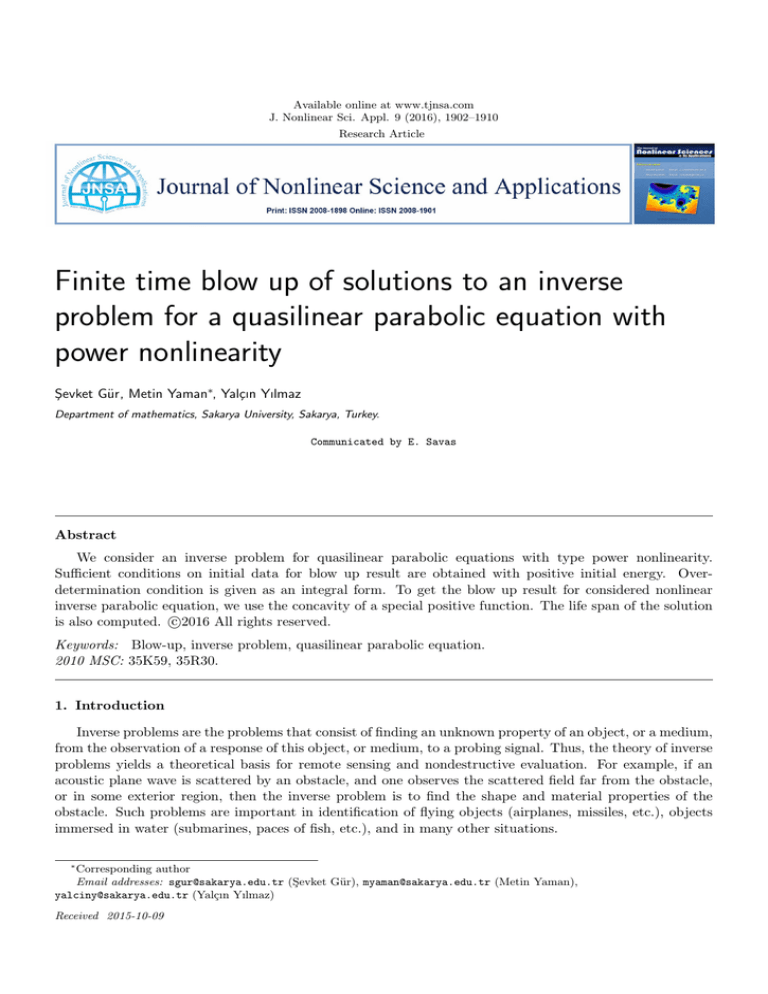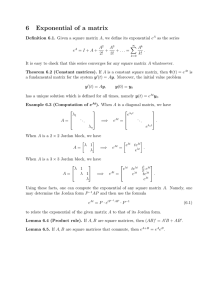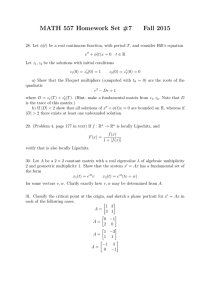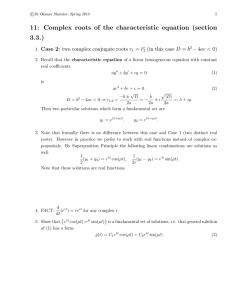
Available online at www.tjnsa.com
J. Nonlinear Sci. Appl. 9 (2016), 1902–1910
Research Article
Finite time blow up of solutions to an inverse
problem for a quasilinear parabolic equation with
power nonlinearity
Şevket Gür, Metin Yaman∗, Yalçın Yılmaz
Department of mathematics, Sakarya University, Sakarya, Turkey.
Communicated by E. Savas
Abstract
We consider an inverse problem for quasilinear parabolic equations with type power nonlinearity.
Sufficient conditions on initial data for blow up result are obtained with positive initial energy. Overdetermination condition is given as an integral form. To get the blow up result for considered nonlinear
inverse parabolic equation, we use the concavity of a special positive function. The life span of the solution
c
is also computed. 2016
All rights reserved.
Keywords: Blow-up, inverse problem, quasilinear parabolic equation.
2010 MSC: 35K59, 35R30.
1. Introduction
Inverse problems are the problems that consist of finding an unknown property of an object, or a medium,
from the observation of a response of this object, or medium, to a probing signal. Thus, the theory of inverse
problems yields a theoretical basis for remote sensing and nondestructive evaluation. For example, if an
acoustic plane wave is scattered by an obstacle, and one observes the scattered field far from the obstacle,
or in some exterior region, then the inverse problem is to find the shape and material properties of the
obstacle. Such problems are important in identification of flying objects (airplanes, missiles, etc.), objects
immersed in water (submarines, paces of fish, etc.), and in many other situations.
∗
Corresponding author
Email addresses: sgur@sakarya.edu.tr (Şevket Gür), myaman@sakarya.edu.tr (Metin Yaman),
yalciny@sakarya.edu.tr (Yalçın Yılmaz)
Received 2015-10-09
Ş. Gür, M. Yaman, Y. Yılmaz, J. Nonlinear Sci. Appl. 9 (2016), 1902–1910
1903
In geophysics one sends an acoustic wave from the surface of the earth and collects the scattered field on
the surface for various positions of the source of the field for a fixed frequency, or for several frequencies. The
inverse problem is to find the subsurface inhomogeneities. In technology one measures the eigenfrequencies
of a piece of a material, and the inverse problem is to find a defect in the material, for example, a hole in
a metal. In geophysics the inhomogeneity can be an oil deposit, a cave, a mine. In medicine it may be a
tumor, or some abnormality in a human body.
We now consider the following inverse problem for a quasilinear parabolic equation
h
i
ut − ∇. k1 + k2 |∇u|m−2 )∇u + h (u, ∇u) − |u|p−2 u = F (t)w(x),
(1.1)
u (x, t) = 0, x ∈ ∂Ω, t > 0,
(1.2)
u (x, 0) = u0 , x ∈ Ω,
Z
u (x, t) w (x) dx = 1, t > 0,
(1.3)
(1.4)
Ω
where Ω ⊂ Rn , n ≥ 1 is a bounded domain with a sufficiently smooth boundary ∂Ω. ρ, k1 and k2 are positive
constants and p > m ≥ 2. Also assume that w(x) is a given function satisfying
Z
w2 (x) dx = 1, w ∈ H m (Ω) ∩ H01 (Ω) ∩ Lp (Ω) , m ≥ 2.
(1.5)
Ω
The inverse problem consists of finding a pair of functions {u (x, t) , F (t)} satisfying (1.1)–(1.4) when
Z
u0 wdx = 1, u0 ∈ H01 (Ω) ∩ Lp (Ω)
(1.6)
Ω
and h (u, ∇u) is a continuous function which satisfies the relation
p
m
|h (u, ∇u)| ≤ K |u| 2 + |∇u| 2 , K > 0.
(1.7)
Additional information about the solution to the inverse problem is given in the form of the integral overdetermination condition (1.4). Temperature u(x, t) is averaged by function w over the domain Ω [10].
Existence and uniqueness of solutions to inverse problems for parabolic equations are studied by several
authors [4, 5, 7, 8, 9]. Asymptotic stability of solutions to such problems are investigated in [2, 9, 10, 11].
Global nonexistence and blow up results for nonlinear parabolic equations are discussed in [1, 3]. But
less is known about inverse problem for nonlinear parabolic equations. Eden and Kalantarov [2] studied the
following problem
ut − ∆u − |u|p u + b (x, t, u, ∇u) = F (t) w (x) , p > 0.
In this work, we consider blow up results in finite time for solutions to inverse problems for nonlinear
parabolic equation (1.1)–(1.4) with weight function w(x). The technique of our proofs is similar to the one
in [1]. In this paper, we use the following notations: kuk = kukL2 (Ω) , kukp = kukLp (Ω) where L2 (Ω) and
R
Lp (Ω) are usual Lebesgue spaces, (u, v) = Ω uvdx is the inner product,
ab ≤ εa2 +
1 2
b , ε>0
4ε
is a form of the weighted arithmetic–geometric inequality for a, b > 0 and
ab ≤ βaq + C(q, β)bq
is the Young‘s inequality with
1
q
+
1
q0
= 1, C (q, β) =
obtaining blow up results for dynamical problems.
0
1
.
0
q 0 (qβ)q /q
The following lemma is a useful tool for
Ş. Gür, M. Yaman, Y. Yılmaz, J. Nonlinear Sci. Appl. 9 (2016), 1902–1910
1904
Lemma 1.1 ([6], Lemma 1). Suppose that a positive, twice differentiable function Ψ (t) satisfies, for t > 0,
the following inequality
2
ψ (t) ψ 00 (t) − (1 + γ) ψ 0 (t) ≥ −2M1 ψ (t) ψ 0 (t) − M2 ψ 2 (t) ,
where γ > 0, M1 , M2 ≥ 0. If ψ (0) > 0, ψ 0 (0) > −γ2 γ −1 ψ (0) and M1 + M2 > 0, then ψ (t) tends to infinity
as
γ1 ψ (0) + γψ 0 (0)
1
ln
,
t → t1 ≤ t2 ≤ p 2
γ2 ψ (0) + γψ 0 (0)
2 M1 + γM2
p
p
where γ1 = −M1 + M12 + γM2 , γ2 = −M1 − M12 + γM2 .
2. Blow-up Result
Theorem 2.1. Suppose that conditions (1.3) and (1.4) are satisfied. Let u(x, t), F (t) be a solution to inverse
problem (1.1)–(1.4). Assume that the following conditions are satisfied
p
p+m−4
K 2 (m + pk2 )(1 + α)
1 + β − 1, β ∈ (0, α) , α =
,λ =
8
k2 (p − m)(α − β)
1
λ
k1
k2
E (0) = − ku0 k2 − k∇u0 k2 −
k∇u0 km
ku0 kpp > 0
m+
2
2
m
p
2λ(1 + γ)2
4 (1 + 2α) E (0) −
ku0 k2 > D3
γ
γ=
(2.1)
(2.2)
(2.3)
where
D3 =
8K 2 (m + pk2 )
4k2 8 (m − 1) m−1
kwk2 +
k∇wkm
m
k2 (p − m)
m
(p − m)
4 8 (p − 1) p−1
4k1
+
kwkpp +
k∇wk2 .
p (p − m)
p+m−4
(2.4)
Then there exists a finite time t1 such that
kuk2 → +∞ as t → t−
1.
Proof For λ > 0, we apply the transformation (x, t) = eλt v(x, t) in (1.1) and obtain the equation
h
i
vt − ∇. (k1 + k2 eλ(m−2)t |∇v|m−2 )∇v + λv + e−λt h eλt v, eλt ∇v − eλ(p−2)t |v|p−2 v = e−λt F (t)w(x) (2.5)
with the boundary condition
v (x, t) = 0,
x ∈ ∂Ω,
t > 0,
(2.6)
the initial condition
v (x, 0) = u0 ,
x ∈ Ω,
and the integral over-determination condition
Z
v (x, t) w(x)dx = e−λt ,
(2.7)
t > 0.
(2.8)
Ω
Multiplying equation (2.5) by vt in L2 (Ω), we get the relation
d λ
k1
k2
1 λ(p−2)t
p
kvk2 + k∇vk2 + eλ(m−2)t k∇vkm
−
e
kvk
m
p
dt 2
2
m
p
k2 λ (m − 2) λ(m−2)t
λ (p − 2) λ(p−2)t
2
−
e
k∇vkm
e
kvkpp
m + kvt k +
m
p
+ e−λt h eλt v, eλt ∇v , vt = −λe−2λt F (t).
(2.9)
Ş. Gür, M. Yaman, Y. Yılmaz, J. Nonlinear Sci. Appl. 9 (2016), 1902–1910
1905
Now, multiplying equation (2.5) by w in L2 (Ω) and using over-determination condition (2.8), then we obtain
F (t) =k1 eλt (∇v, ∇w) + k2 eλ(m−1)t |∇v|m−2 ∇v, ∇w
(2.10)
+ h eλt v, eλt ∇v , w − eλ(p−1)t |v|p−2 v, w .
Substituting equation (2.10) into equation (2.9) we get the relation
−
d
λk2 (m − 2) λ(m−2)t
λ (p − 2) λ(p−2)t
2
E (t) −
e
k∇vkm
e
kvkpp
m + kvt k +
dt
m
p
=e−λt h eλt v, eλt ∇v , vt − λe−2λt h eλt v, eλt ∇v , w
− λk2 eλ(m−3)t |∇v|m−2 ∇v, ∇w + λeλ(p−3)t |v|p−2 v, w − λk1 e−λt (∇v, ∇w) ,
where
(2.11)
k2
λ
1
k1
2
E (t) = eλ(p−2)t kvkpp − eλ(m−2)t k∇vkm
k∇vk2 .
m − kvk −
p
m
2
2
Use the property of the function h(eλt v, eλt ∇v) given by (1.7) and then apply the weighted arithmetic–
geometric inequality to the first term on the right-hand side of (2.11) with a = eλ(p−2)t/2 kvkp/2
p , b = K kvt k,
ε=
λ(p−m)
4p
and a = eλ(m−2)t/2 k∇vkm/2
m , b = K kvt k, ε =
λk2 (p−m)
4m
to get the estimate
λ (p − m)
λk2 (p − m) λ(m−2)t
e−λt (h eλt v, eλt ∇v , vt ) ≤
eλ(p−2)t kvkpp +
e
k∇vkm
m
4p
4m
K 2 (m + pk2 )
kvt k2 .
+
λk2 (p − m)
(2.12)
We can obtain a similar result for the second term on the right-hand side of (2.11) with a = eλ(p−2)t/2 kvkp/2
p ,
b = λK kwk, ε =
λ(p−m)
8p
and a = eλ(m−2)t/2 k∇vkm/2
m , b = λK kwk, ε =
λk2 (p−m)
4m
λ (p − m)
λk2 (p − m) λ(m−2)t
λe−2λt (h eλt v, eλt ∇v , w) ≤
eλ(p−2)t kvkpp +
e
k∇vkm
m
8p
8m
2
2λK (m + pk2 ) −2λt
+
e
kwk2 .
k2 (p − m)
(2.13)
Apply Young’s inequality to the third and fourth terms on the right-hand side of (2.11) with
e
λ(m−2)(m−1)
t
m
k∇vkm−1
, b = λk2 e
m
−2λt
m
k∇wm k , ε =
and
a=e
λ(p−2)(p−1)t
p
kvkp−1
, λe
p
−2λt
p
kwkp , ε =
λk2 (p − m)
8m
λ (p − m)
8p
to get the estimates, respectively
λk (p − m)
2
λk2 eλ(m−3)t (|∇v|m−2 ∇v, ∇w) ≤
eλ(m−2)t k∇vkm
m
8m
m−1
λk2 8 (m − 1)
+
e−2λt k∇wkm
m,
m
p−m
λ (p − m)
λeλ(p−3)t |v|p−2 v, w ≤
eλ(p−2)t kvkpp
8p
λ 8 (p − 1) p−1 −2λt
+
e
kwkpp .
p
p−m
(2.14)
(2.15)
Ş. Gür, M. Yaman, Y. Yılmaz, J. Nonlinear Sci. Appl. 9 (2016), 1902–1910
1906
The last term on the right-hand side of (2.11) can be estimated by weighted arithmetic–geometric inequality
with a = k∇vk, b = λk1 e−λt k∇wk, ε = λk1 (p+m−4)
4
λk1 e−λt |(∇v, ∇w)| ≤
λk1 (p + m − 4)
λk1
k∇vk2 +
e−2λt k∇wk2 .
4
p+m−4
(2.16)
Substituting (2.12)–(2.16) into equation (2.11), we get
d
λ
λ2
E (t) ≥ (p + m − 4) E (t) +
(p + m − 4) kvk2
dt
2
2 k1
K 2 (m + pk2 )
2
kvt k2 − D0 e−2λt ,
+
(p + m − 4) k∇vk + 1 −
4
λk2 (p − m)
(2.17)
where
2λK 2 (m + pk2 )
λk2 8 (m − 1) m−1
2
D0 =
kwk +
k∇wkm
m
k2 (p − m)
m
p−m
p−1
λk1
λ 8 (p − 1)
kwkpp +
k∇wk2 .
+
p
p−m
p+m−4
Using (2.1), we rewrite the inequality (2.17) as follows
d
λ
λ2
E (t) ≥ (p + m − 4) E (t) +
(p + m − 4) kvk2
dt
2
2
λk1
1+β
2
+
(p + m − 4) k∇vk +
kvt k2 − D0 e−2λt .
4
1+α
(2.18)
Since p + m − 4 > 0, the second and third terms on the right-hand side of (2.18) can be omitted to get the
inequality
d
λ
1+β
E (t) ≥ (p + m − 4) E (t) +
kvt k2 − D0 e−2λt .
(2.19)
dt
2
1+α
λ
Solving the differential inequality (2.19) with the estimation 1 − e− 2 (p+m)t by 1, we get
E (t) ≥ (E (0) − D1 )e
λ
(p+m−4)t
2
+
1+β
1+α
Zt
kvτ k2 dτ,
(2.20)
0
where D1 =
2D0
λ(p+m) .
It is easy to see that
λ
E (t) ≥ e 2 (p+m−4)t (E (0) − D1 ) ≥ E (0) − D1
by assumption (2.4). Thus we obtain a lower bound for E(t):
E (t) ≥
1+β
1+α
Zt
kvτ k2 dτ + E (0) − D1 .
(2.21)
0
Multiplying the equation (2.5) by v in L2 (Ω) and using (2.10), we get
1d
λ(p−2)t
kvk2 + λkvk2 + k1 k∇vk2 + k2 eλ(m−2)t k∇vkm
kvkpp
m−e
2 dt
= − e−λt h eλt v, eλt ∇v , v + k2 eλ(m−3)t (|∇v|m−2 ∇v, ∇w) + e−2λt h eλt v, eλt ∇v , w
− e(p−3)λt |v|p−2 v, w + k1 e−λt (∇v, ∇w) .
(2.22)
Ş. Gür, M. Yaman, Y. Yılmaz, J. Nonlinear Sci. Appl. 9 (2016), 1902–1910
1907
Recall condition (1.7) and apply the weighted arithmetic–geometric inequality to the first term on
the right-hand side of the equation (2.22) with a = e
e
λ(m−2)
t
2
k∇vkm/2
m ,
b = K kvk, ε =
k2 (p−m)
4m
λ(p−2)
t
2
kvkp/2
p , b = K kvk, ε =
p−m
4p
and a =
to get the estimate
p−m
k2 (p − m) λ(m−2)t
e−λt (h eλt v, eλt ∇v , v) ≤
eλ(p−2)t kvkpp +
e
k∇vkm
m
4p
4m
K 2 (m + pk2 )
+
kvk2 .
k2 (p − m)
We can find a similar result for the third term on the right-hand side of (2.22) with a = e
b = K kwk, ε =
p−m
8p
and a = e
λ(m−2)
t
2
k∇vkm/2
m , b = K kwk, ε =
(2.23)
λ(p−2)
t
2
kvkp/2
p ,
k2 (p−m)
8m
p−m
k2 (p − m) λ(m−2)t
e−2λt (h eλt v, eλt ∇v , w) ≤
eλ(p−2)t kvkpp +
e
k∇vkm
m
8p
8m
2K 2 (m + pk2 ) −2λt
+
e
kwk2 .
k2 (p − m)
(2.24)
Apply Young’s inequality to the second and fourth terms on the right-hand side of equation (2.22) with
a=e
ε=
λ(m−2)(m−1)
t
m
(p−m)
8p
k∇vkm−1
m , b = k2 e
−2λ
t
m
k∇wkm , ε =
k2 (p−m)
8m
and a = e
λ(p−2)(p−1)
t
p
kvkp−1
p , b = e
−2λ
t
p
kwkp ,
to get the estimates, respectively,
k (p − m)
2
eλ(m−2)t k∇vkm
k2 eλ(m−3)t (|∇v|m−2 ∇v, ∇w) ≤
m
8m
m−1
k2 8 (m − 1)
+
e−2λt k∇wkm
m,
m (p − m)
p − m
eλ(p−2)t kvkpp
eλ(p−3)t |v|p−2 v, w ≤
8p
1 8 (p − 1) p−1 −2λt
+
e
kwkpp .
p (p − m)
(2.25)
(2.26)
The last term on the right-hand side of equation (2.22) can be estimated by using the weighted arithmetic–
geometric inequality with a = k∇vk, b = k1 e−λt k∇wk, ε = k1 (p+m−4)
4
k1 e−λt |(∇v, ∇w)| ≤
k1 (p + m − 4)
k1
k∇vk2 +
e−2λt k∇wk2 .
4
p+m−4
(2.27)
Substitute estimates (2.23)–(2.27) into (2.22), we obtain the following differential inequality
1 d 2 p + m λ(p−2)t
k2 (p + m) λ(m−2)t
v ≥
e
kvkpp −
e
k∇vkm
m
2 dt
2p
2m
K 2 (m + pk2 )
k1 (p + m)
− λ+
kvk2 −
k∇vk2 − D2 e−2λt ,
k2 (p − m)
4
where
2K 2 (m + pk2 )
k2 8 (m − 1) m−1
2
kwk +
k∇wkm
D2 =
m
k2 (p − m)
m
p−m
p−1
1 8 (p − 1)
k1
+
kwkpp +
k∇wk2 .
p p−m
p+m−4
(2.28)
Ş. Gür, M. Yaman, Y. Yılmaz, J. Nonlinear Sci. Appl. 9 (2016), 1902–1910
1908
Rewrite inequality (2.28) as follows
1d
p+m
λ (p + m − 4) K 2 (m + pk2 )
2
kvk2 − D2 e−2λt .
kvk ≥
E (t) +
−
2 dt
2
4
k2 (p − m)
(2.29)
Since −D2 e−2λt ≥ −D2 and p + m − 4 > 0, we can write (2.29) as
1d
p+m
K 2 (m + pk2 )
kvk2 ≥
E (t) −
kvk2 − D2 .
2 dt
2
k2 (p − m)
(2.30)
Substituting the estimate (2.21) and p + m = 4(1 + 2α) into (2.30), we obtain
1d
kvk2 ≥2 (1 + 2α)
2 dt
1+β
1+α
Zt
kvτ k2 dτ
(2.31)
0
+ 2 (1 + 2α) (E (0) − D1 ) − D2 −
Since λ >
K 2 (m+pk2 )
k2 (p−m) ,
K 2 (m
+ pk2 )
kvk2 .
k2 (p − m)
by assumption (2.1), then it follows from (2.31)
d
kvk2 ≥ 4 (1 + 2α)
dt
1+β
1+α
Zt
kvτ k2 dτ − 2λkvk2 + 4 (1 + 2α) E (0) − D3 ,
(2.32)
0
where D3 = 4 (1 + 2α) D1 + 2D2 .
Now let us introduce the positive function
Zt
ψ (t) =
kvk2 dτ + C0 ,
(2.33)
0
where C0 is a positive constant that will be chosen later. The first and second derivatives of (2.33) are given
by
0
2
Zt
ψ (t) = kvk = 2
(v, vτ ) dτ + ku0 k2 ,
(2.34)
0
d
ψ (t) = kvk2 .
dt
00
(2.35)
Apply the Cauchy–Schwarz inequality and the weighted arithmetic–geometric inequality to get an upper
0
bound for ψ (t):
t
2
Z
0 2
1
ψ (t) = 4 (v, vτ ) dτ + ku0 k2
2
0
v
v
2
uZ t
uZ t
u
u
1
u
u
≤ 4t kvk2 dτ t kvτ k2 dτ + ku0 k2
2
0
0
Zt
≤ 4 (1 + 4ε)
0
t
Z
1
1
kvk2 dτ kvτ k2 dτ +
1+
ku0 k4 .
4
4ε
0
(2.36)
Ş. Gür, M. Yaman, Y. Yılmaz, J. Nonlinear Sci. Appl. 9 (2016), 1902–1910
1909
Recalling the relations (2.33)–(2.36), we can estimate the term ψψ 00 − (1 + γ) (ψ 0 )2 :
t
Z
2
ψψ 00 − (1 + γ) ψ 0 ≥4 (1 + β) kvτ k2 dτ ψ + [(p + m) E (0) − D3 ] ψ − 2λkvk2 ψ
0
t
t
Z
Z
− 4 (1 + γ) (1 + 4ε) kvk2 dτ kvτ k2 dτ
0
(2.37)
0
1
ku0 k4 .
− (1 + γ) 1 +
4ε
It also should benoted that, since
(and so γ) can be neglected, ε > 0 can be taken in this way followed
β 1+β
1
by assumption max 1 + 4ε, 1 + 4ε
= 1+γ .
By assumption (2.1) and inequality (2.37), we get the estimation
ψψ 00 − (1 + γ) ψ 0
2
≥ −2λψψ 0 + ((p + m) E (0) − D3 ) C0 − (1 + γ)2 ku0 k4 .
Now Lemma 1.1 can be applied if
C0 =
(1 + γ)2
ku0 k4 .
(p + m) E (0) − D3
(2.38)
3. Conclusion
We get the relation ψψ 00 − (1 + γ) (ψ 0 )2 ≥ −2λψψ 0 , with M1 = λ, M2 = 0, γ1 = 0, γ2 = −2λ. The
conditions of Lemma 1, positivity of ψ(0) and the condition ψ 0 (0) > −γ2 γ −1 ψ (0) are satisfied by the
constant (2.38) and the assumption (2.3) respectively. Thus solutions to the inverse problem for nonlinear
parabolic equation (1.1)–(1.4) blow up as
t → t1 ≤
1
γ((p + m) E (0) − D3 )
ln
.
2λ γ((p + m) E (0) − D3 ) − 2λ(1 + γ)2 ku0 k2
As a result, we find conditions on data, guaranteeing global nonexistence of solution to an inverse source
problem for a class of nonlinear parabolic equations.
Acknowledgement
The authors would like to thank to their late professor, Professor Hamdi Arıkan, for his invaluable
guidance, suggestions and comments in our academic life.
References
[1] B. A. Bilgin, V. K. Kalantarov, Blow up of solutions to the initial boundary value problem for quasilinear strongly
damped wave equations, J. Math. Anal. Appl., 403 (2013), 89–94. 1
[2] A. Eden, V. K. Kalantarov, On global behavior of solutions to an inverse problem for nonlinear parabolic equations,
J. Math. Anal. Appl., 307 (2005), 120–133. 1
[3] D. Erdem, Blow up solutions to quasilinear parabolic equations, Appl. Math. Lett., 12 (1999), 65–69. 1
[4] Ö. F. Gözükızıl, M. Yaman, A note on the unique solvability of an inverse problem with integral overdetermination,
Appl. Math. E-notes, 8 (2008), 223–230. 1
[5] Z. Junning, Existence and nonexistence of solutions for ut = div |∇u|p−2 ∇u + f (∇u, u, x, t), J. Math. Anal.
Appl., 172 (1993), 130–146. 1
[6] V. K. Kalantarov, O. A. Ladyzhenskaya, Formation of collapses in quasilinear equations of parabolic and hyperbolic
types, Zap. Nauchn. Sem. Leningrad. Otdel. Mat. Inst. Steklov., 69 (1977), 77–102. 1.1
Ş. Gür, M. Yaman, Y. Yılmaz, J. Nonlinear Sci. Appl. 9 (2016), 1902–1910
1910
[7] A. I. Prilepko, D. G. Orlovskii, I. A. Vasin, Methods for Solving Inverse Problems in Mathematical Physics, Marcel
Dekker, New York, (2000). 1
[8] A. G. Ramm, Inverse problems, Mathematical and Analytical Techniques with Applications to Engineering,
Springer, New York, (2005). 1
[9] R. Riganti, E. Savateev, Solution of an inverse problem for the nonlinear heat equation, Commun. Partial Differ.
Equations, 19 (1994), 1611–1628. 1
[10] I. A. Vasin, V. L. Kamynin, On the asymptotic behavior of solutions to inverse problems for parabolic equations,
Sib. Math. J., 38 (1997), 647–662. 1
[11] M. Yaman, Ö. F. Gözükızıl, Asymptotic behaviour of the solutions of inverse problems for pseudo-parabolic
equations, Appl. Math Comput., 154 (2004), 69–74. 1







